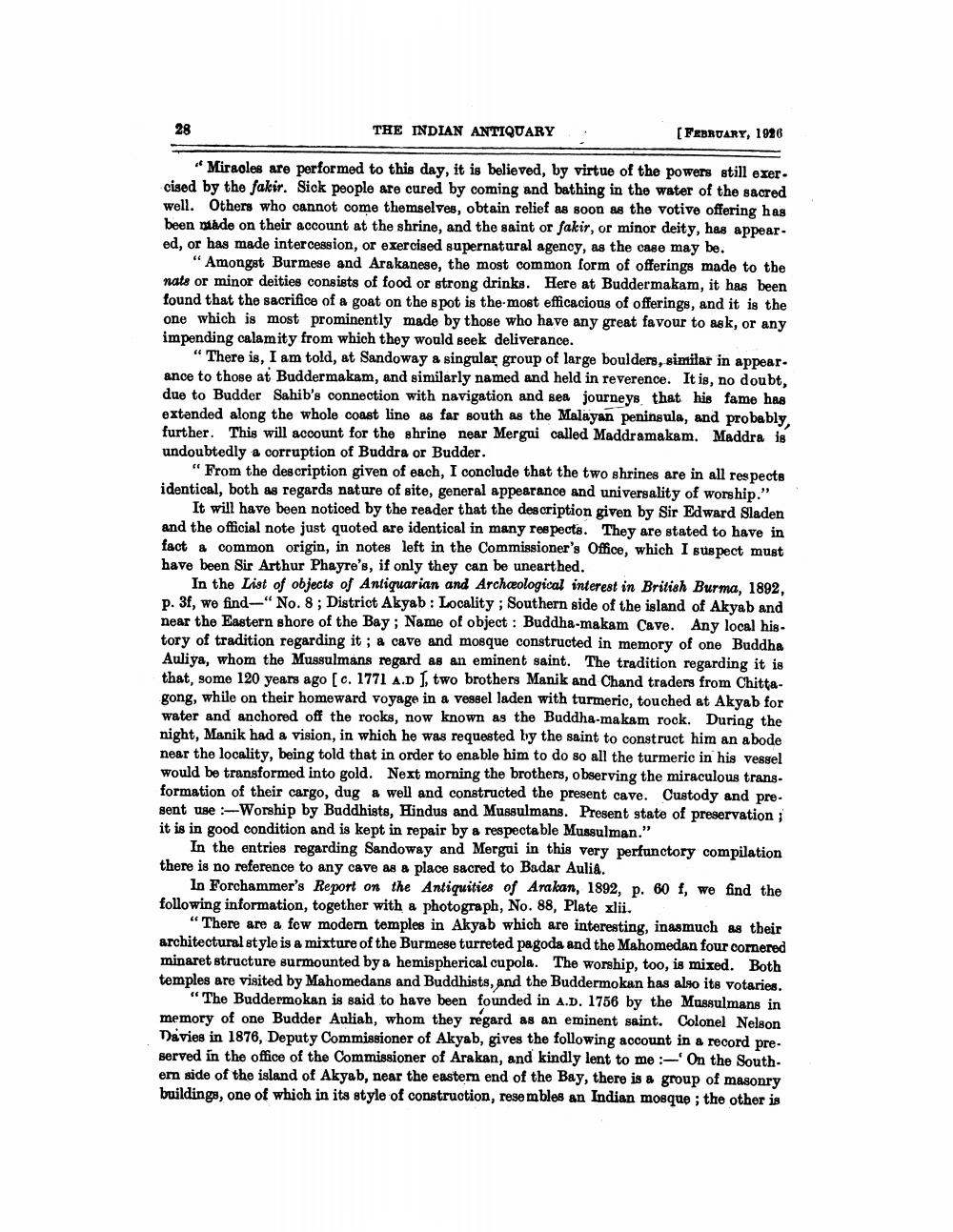________________
28
THE INDIAN ANTIQUARY
[ FEBRUARY, 1926
"Miracles are performed to this day, it is believed, by virtue of the powers still exer. cised by the fakir. Sick people are cured by coming and bathing in the water of the sacred well. Others who cannot come themselves, obtain relief as soon as the votive offering has been made on their account at the shrine, and the saint or fakir, or minor deity, has appeared, or has made intercession, or exercised supernatural agency, as the case may be.
"Amongst Burmese and Arakanese, the most common form of offerings made to the nats or minor deities consists of food or strong drinks. Here at Buddermakam, it has been found that the sacrifice of a goat on the spot is the most efficacious of offerings, and it is the one which is most prominently made by those who have any great favour to ask, or any impending calamity from which they would seek deliverance.
“There is, I am told, at Sandoway a singular group of large boulders, similar in appear. ance to those at Buddermakam, and similarly named and held in reverence. It is, no doubt, due to Budder Sahib's connection with navigation and sea journeys that his fame has extended along the whole coast line as far south as the Malayan peninsula, and probably, further. This will account for the shrine near Mergui called Maddramakam. Maddra is undoubtedly a corruption of Buddra or Budder.
"From the description given of each, I conclude that the two shrines are in all respecte identical, both as regards nature of site, general appearance and universality of worship."
It will have been noticed by the reader that the description given by Sir Edward Sladen and the official note just quoted are identical in many respects. They are stated to have in fact & common origin, in notes left in the Commissioner's Office, which I suspect must have been Sir Arthur Phayre's, if only they can be unearthed.
In the List of objects of Antiquarian and Archcological interest in British Burma, 1892, p. 3f, we find-"No. 8; District Akyab: Locality ; Southern side of the island of Akyab and near the Eastern shore of the Bay; Name of object : Buddha-makam Cave. Any local history of tradition regarding it ; a cave and mosque constructed in memory of one Buddha Auliya, whom the Mussulmans regard as an eminent saint. The tradition regarding it is that, some 120 years ago [c. 1771 A.D ), two brothers Manik and Chand traders from Chittagong, while on their homeward voyage in a vessel laden with turmeric, touched at Akyab for water and anchored off the rocks, now known as the Buddha-makam rock. During the night, Manik had a vision, in which he was requested by the saint to construct him an abode near the locality, being told that in order to enable him to do so all the turmeric in his vessel would be transformed into gold. Next morning the brothers, observing the miraculous transformation of their cargo, dug a well and constructed the present cave. Custody and pre. gent use - Worship by Buddhists, Hindus and Mussulmans. Present state of preservation ; it is in good condition and is kept in repair by a respectable Mussulman."
In the entries regarding Sandoway and Mergui in this very perfunctory compilation there is no reference to any cave as a place sacred to Badar Aulia.
In Forchammer's Report on the Antiquities of Arakan, 1892, p. 60 f, we find the following information, together with a photograph, No. 88, Plate xlii.
“There are a few modem temples in Akyab which are interesting, inasmuch as their architectural style is a mixture of the Burmese turreted pagoda and the Mahomedan four cornered minaret structure surmounted by a hemispherical cupola. The worship, too, is mixed. Both temples are visited by Mahomedans and Buddhists, and the Buddermokan has also its votaries.
“The Buddermokan is said to have been founded in A.D. 1756 by the Musulmans in memory of one Budder Auliah, whom they regard as an eminent saint. Colonel Nelson Davies in 1876, Deputy Commissioner of Akyab, gives the following account in a record preserved in the office of the Commissioner of Arakan, and kindly lent to me:- On the Southern side of the island of Akyab, near the eastem end of the Bay, there is a group of masonry buildings, one of which in its style of construction, resembles an Indian mosque ; the other is




